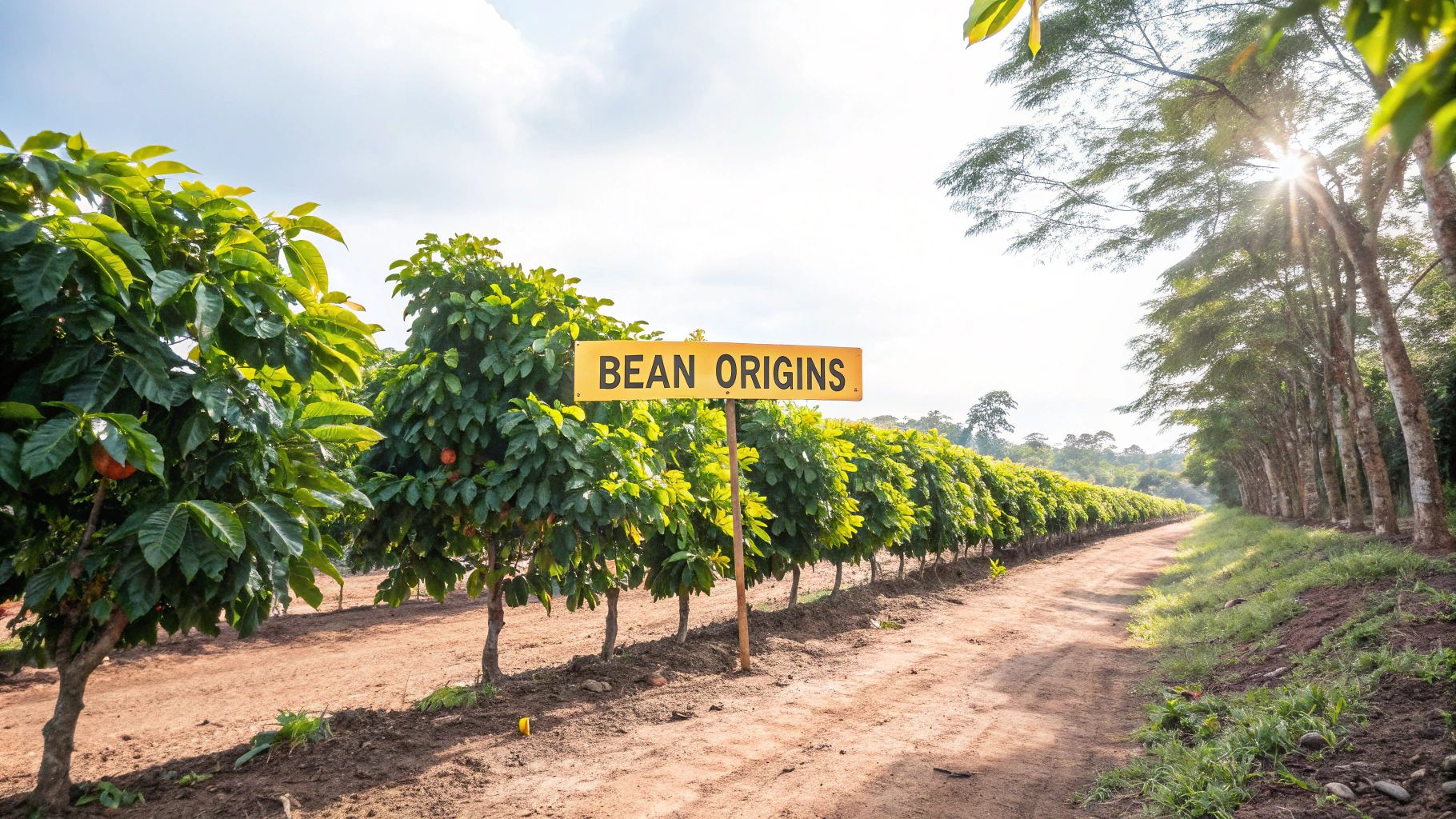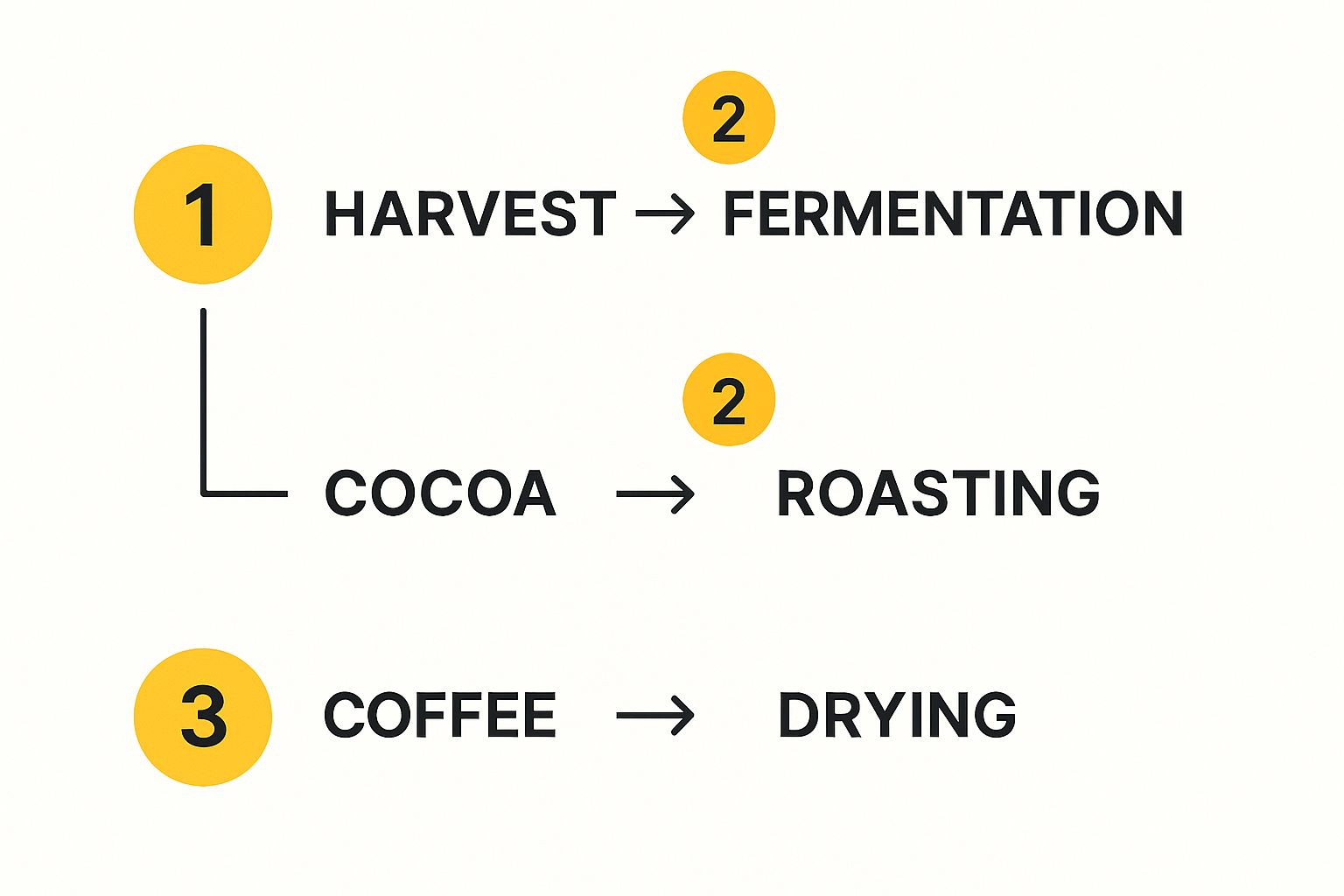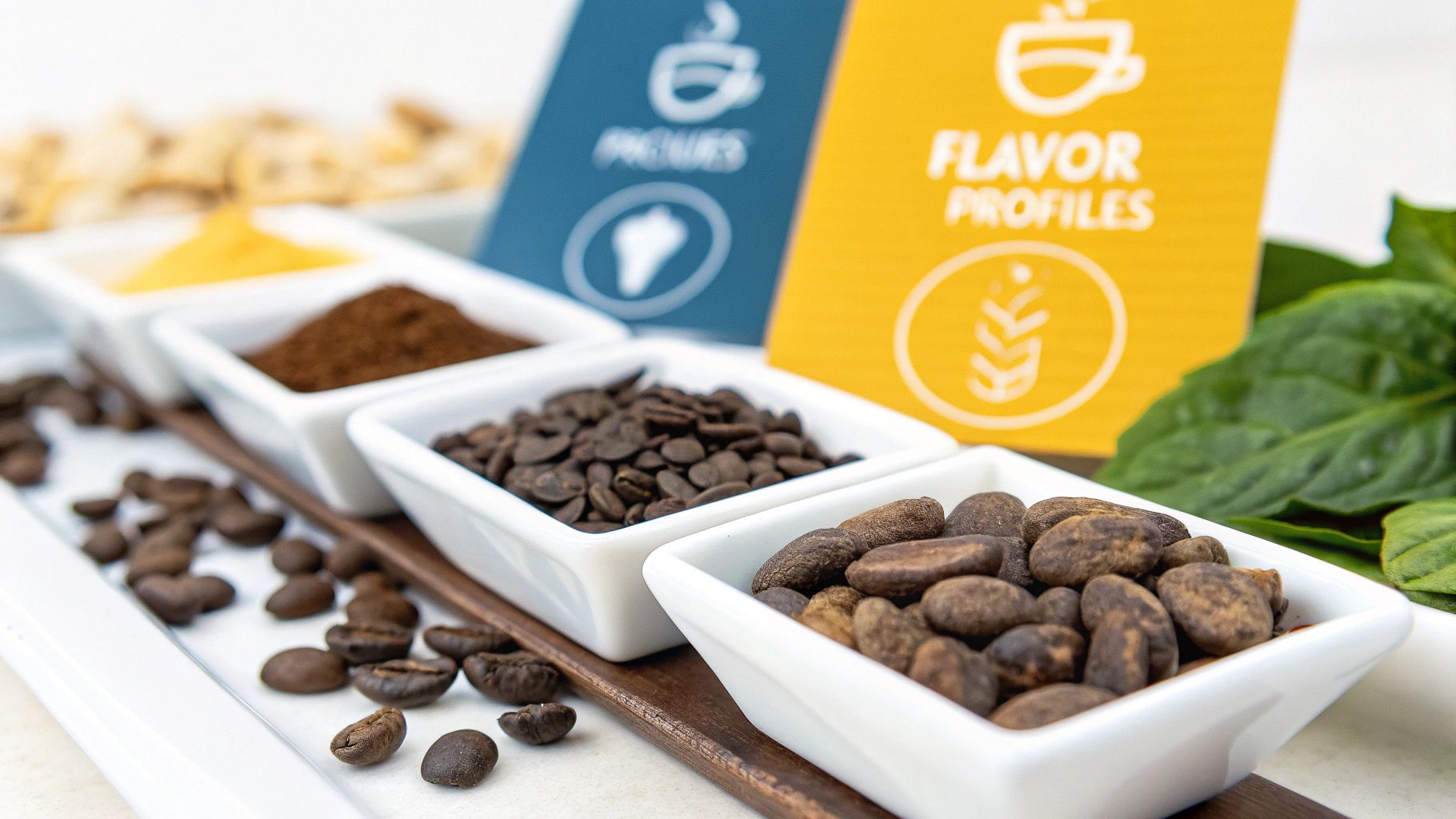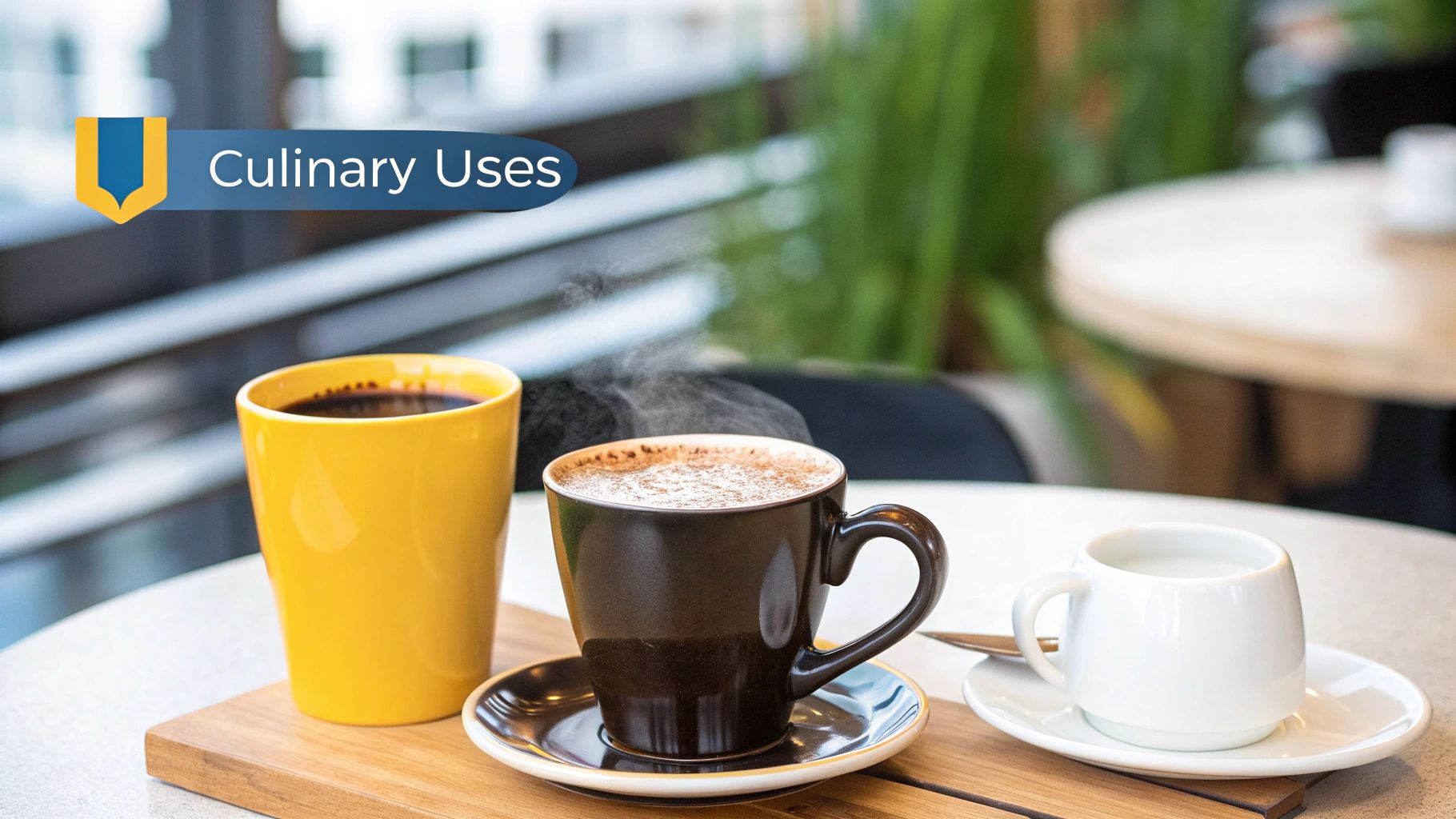When you get right down to it, the whole cocoa beans vs coffee beans discussion boils down to two very different plants that give us two very different experiences. Sure, they’re both seeds from tropical plants that end up as beloved beverages, but that's where the similarities start to fade.
Cocoa beans, from the Theobroma cacao tree, deliver a gentle, mood-lifting buzz thanks to a compound called theobromine. Coffee beans, from the Coffea plant, pack a much sharper punch with a heavy dose of caffeine. They’re simply not in the same league, each with its own unique flavor, processing journey, and cultural footprint.
Unpacking Two Global Powerhouses
On the surface, cocoa and coffee seem to follow a similar script. Both start as seeds inside a fruit, grow in the world's "Bean Belt" near the equator, and go through a process of fermentation, drying, and roasting to bring out those flavors we know and love.
But that's where their stories diverge. Cocoa is the soul of chocolate, celebrated for its deep, complex richness. Coffee, on the other hand, is prized for its bright, sharp acidity and that distinctively aromatic bitterness.
Knowing the difference isn't just for foodies; it's practical. Are you looking for a morning pick-me-up or a key ingredient for a decadent dessert? Your choice isn't just about taste—it's about the kind of effect you want on your body and mind.
Cocoa vs Coffee At a Glance
Let's break down the fundamental differences. This table gives you a high-level look at what sets these two beans apart, from their family tree to the active compounds that give them their kick.
| Attribute | Cocoa Beans | Coffee Beans |
|---|---|---|
| Plant Source | Theobroma cacao tree | Coffea plant (e.g., Arabica, Robusta) |
| Primary Stimulant | Theobromine (milder, longer-lasting) | Caffeine (stronger, faster-acting) |
| Typical Flavor Profile | Rich, chocolatey, fruity, nutty | Bitter, acidic, earthy, floral |
| Origin | Amazon Basin, South America | Highlands of Ethiopia, Africa |
| Primary Use | Chocolate, cocoa powder, cocoa butter | Brewed coffee, espresso, instant coffee |
The real takeaway here is how they affect you. Coffee’s caffeine hits the central nervous system fast, giving you that immediate jolt of alertness. Cocoa's theobromine is more of a gentle nudge—it relaxes muscles and stimulates the heart for a calm, sustained energy without the jittery side effects.
With this foundation, we can really dig into how these two incredible beans have carved out their places in our cultures, economies, and daily routines across the globe.
Where Do They Come From? A Look at Origins and Cultivation

While cocoa and coffee both call the world's tropical regions home, their family trees are rooted in entirely different continents. Their stories begin thousands of miles apart, which is the first clue to understanding why they're so fundamentally different.
Cocoa, from the Theobroma cacao tree, is a true native of the Amazon rainforest's humid, shaded understory in South America. Coffee, on the other hand, traces its lineage back to the high-altitude forests of Ethiopia, where the Coffea plant first grew wild.
This simple geographical fact—a lowland jungle plant versus a highland mountain shrub—has shaped everything from how they’re farmed to how they taste in your cup. It's a classic tale of two very different plants that went on to conquer the world.
The Cacao Tree: A Gift from the Amazon
The Theobroma cacao tree is a bit of a diva. It insists on very specific, jungle-like conditions to produce its famous pods. Its flowers are tiny and sprout directly from the trunk and main branches, a strange and wonderful feature called cauliflory. From these, the iconic football-shaped pods grow, each one holding the beans that eventually become chocolate.
Getting a cacao tree to thrive means recreating its natural Amazonian habitat. It's a delicate balance.
- Shade is a must: Young cacao trees can't handle direct sun. Farmers often plant them under the canopy of larger "mother trees" like banana or rubber for protection.
- It needs humidity: This isn't a desert plant. Consistent moisture in the air is critical for it to fruit properly.
- Fertile, well-drained soil: The roots need rich nutrients but hate sitting in water.
The botanical name, Theobroma cacao, literally means "food of the gods." Swedish botanist Carl Linnaeus coined it, inspired by the deep reverence the ancient Maya and Aztec civilizations had for cocoa. For them, it wasn't just food; it was used in sacred rituals and even as currency.
This dependence on a unique ecosystem is why cocoa farming is clustered in a narrow band around the equator, with major production hubs in West Africa, Latin America, and parts of Southeast Asia.
The Coffee Plant: An African Highland Native
Coffee's journey starts with the Coffea plant, an evergreen shrub that produces bright red fruits known as "cherries." Inside each cherry are the two seeds we call coffee beans. The two main players in the coffee world, Coffea arabica (Arabica) and Coffea canephora (Robusta), have their own preferences.
Arabica, which makes up over 60% of the world's coffee, is the picky one. It craves high altitudes—think 1,000 to 2,000 meters up—with mild temperatures and clear rainy and dry seasons. This is precisely why the most sought-after beans often come from volcanic mountain ranges. If you're curious about this, you can learn more about what is single origin coffee and see how that environment shapes the final flavor.
Robusta is the tougher sibling. It’s more resilient and perfectly happy growing in hotter climates and at lower elevations.
Despite their different needs, both plants thrive in the same global neighborhood, often called the "Bean Belt." This zone hugs the equator between the Tropics of Cancer and Capricorn, creating the perfect stage for both of these incredible plants to flourish.
The Journey From Harvest to Your Cup
How a fresh-picked fruit becomes the roasted bean we know and love is where cocoa and coffee really start to show their true colors. Both journeys involve harvesting, drying, and roasting, of course, but the steps in between couldn't be more different. These careful processing stages aren't just for preservation—they're what unlock the deep, complex flavors that make each bean so unique.
For cocoa, the magic starts the second those big pods are cracked open. The beans, covered in a sweet, white pulp, are scooped out and piled together for what is arguably the most critical step in making chocolate: fermentation. This process can last up to a week, and it's where the precursors to that classic chocolatey flavor are born.
Coffee’s path takes a sharp turn right after picking. Instead of a long fermentation, the goal is to get the bean out of the fruit, or "cherry," as efficiently as possible. The method used to do this dramatically shapes the final taste you get in your cup.
This breakdown shows just how different those crucial early stages are for developing the distinct flavors of cocoa and coffee.

As you can see, fermentation is a non-negotiable step for creating cocoa's flavor. Coffee, on the other hand, has multiple processing paths, each one crafting a unique sensory profile before the roasting even begins.
How Cocoa Becomes Chocolate
Once fermented, cocoa beans are spread out to dry, a slow process that drops their moisture content from around 60% down to a stable 7%. After drying, they're bagged and shipped off to chocolate makers who will roast, grind, and refine them into the finished product.
The whole thing is a delicate dance between science and tradition, heavily shaped by local conditions. On a global scale, cocoa bean production has been facing major shifts due to climate and farming challenges. For the recent cocoa year, worldwide production was expected to drop by 12.9%, yet exports of beans and semi-finished products actually grew by 6.1% in the first quarter. You can dive deeper into these global cocoa market trends on ICCO.org.
How Coffee Develops Its Character
Coffee processing is a true craft, with three main methods that set the bean's flavor profile before it ever hits the roaster. Each technique is all about controlling how much of the fruit pulp, or mucilage, stays on the bean while it dries.
- Washed Process: Here, the fruit is completely scrubbed off the beans with water before they dry. This gives you a clean, bright, and acidic cup that lets the bean’s origin flavors shine through.
- Natural Process: The entire coffee cherry is dried whole, with the bean still tucked inside. This method is known for producing intense, sweet, and fruity flavors, as the bean soaks up sugars from the drying fruit.
- Honey Process: This is a middle-ground approach. Some, but not all, of the fruit pulp is left on the bean as it dries, creating a beautifully balanced cup with a round body and noticeable sweetness.
The key difference really comes down to intent. Cocoa fermentation is absolutely essential to create the foundational chocolate flavor. Coffee processing is all about preserving and shaping the bean's existing flavors, which are then fully brought to life during roasting.
This fundamental difference in processing is a cornerstone of the cocoa beans vs. coffee beans comparison. It shows how human hands guide two humble seeds toward two completely different sensory experiences. It’s also why the integrity of this process is so important, underscoring the need for ethical sourcing. You can learn more about this in our guide on what Fair Trade coffee is and why it matters.
Comparing Flavor Profiles and Active Compounds

When you sip a cup of hot chocolate or a fresh-brewed coffee, you're experiencing a complex world of chemistry. Both beans are roasted to unlock their incredible flavors, but the specific compounds that create their unique tastes and effects are worlds apart. This is where the cocoa beans vs coffee beans comparison gets really interesting.
For cocoa, the magic starts with fermentation. This crucial step develops the flavor precursors that, once roasted, transform into the deep, rich notes we all know and love in chocolate—everything from fruity and floral to nutty and earthy.
Coffee's personality, on the other hand, is defined more by its origin and how dark it's roasted. The roasting process caramelizes sugars and brings out essential oils, creating a massive spectrum of flavors. You can get bright, acidic notes in a light roast or a bold, smoky profile in a dark one. To really get a feel for this, it's worth exploring the different types of coffees out there.
The Stimulants: Theobromine vs. Caffeine
The biggest difference between the two is what gives them their kick. Cocoa's primary active compound is theobromine, a much milder stimulant than its famous cousin. It provides a gentle, sustained lift without the jittery peak and subsequent crash.
Coffee, of course, is all about caffeine. It’s a powerful central nervous system stimulant that delivers that quick, sharp jolt of energy and focus so many of us count on to get the day started.
The core distinction is the quality of the energy boost. Theobromine offers a calm, almost heart-opening sensation that can last for hours. Caffeine delivers an intense, immediate hit to your mental focus. What you choose really comes down to the kind of stimulation you're looking for at that moment.
This fundamental chemical difference explains why a mug of hot cocoa feels so comforting and relaxing, while an espresso shot is all about getting you primed for action.
Antioxidants and How They Shape Flavor
Both beans are loaded with powerful antioxidants, but they bring different types to the party. These phytonutrients aren’t just good for you; they play a huge role in what you taste.
-
Cocoa's Flavonoids: Raw cocoa is one of the planet's richest sources of flavonoids, which are celebrated for their cardiovascular benefits. These compounds are also responsible for the slightly bitter, astringent, and complex flavors you find in high-quality dark chocolate.
-
Coffee's Chlorogenic Acids: Coffee is a major source of chlorogenic acids (CGAs), which are also linked to a host of health benefits. In the cup, CGAs contribute to coffee's perceived acidity and bitterness, creating the crisp, bright notes that define so many fantastic brews.
The world's love for cocoa's unique properties just keeps growing. The cocoa bean market was recently valued at around USD 14.40 billion and is projected to hit USD 17.30 billion within five years. This growth is driven by our ever-increasing appreciation for good chocolate and new farming technologies that are boosting yields.
At the end of the day, the distinct chemistry of each bean dictates its flavor and feel. One gives you a gentle, complex richness, while the other delivers a sharp, invigorating brightness.
A Look at the Health and Nutritional Side
When you stack cocoa and coffee beans against each other from a health perspective, it’s not a simple case of one being "better." Both are loaded with beneficial compounds, but how we eat or drink them makes all the difference. In their raw, unprocessed states, they're both nutritional heavy-hitters.
Raw cocoa, for instance, is a fantastic source of minerals, especially magnesium, which plays a huge role in everything from muscle function to energy. It's also packed with flavonoids—powerful antioxidants that research suggests can improve heart health by promoting better blood flow and healthy blood pressure. It's these very compounds that give pure cocoa its characteristically intense, slightly bitter flavor.
Coffee, on the other hand, gets its fame from a different class of antioxidants called chlorogenic acids. These have been linked to a number of positive health outcomes, including a lower risk for some chronic diseases. The biggest difference, though, is the stimulant. Coffee gives you that immediate jolt of alertness from caffeine, whereas cocoa’s theobromine provides a much gentler, longer-lasting energy boost without the jitters.
The Antioxidant Showdown
Both beans are antioxidant champions, but they bring different strengths to the table in the fight against cellular damage.
- Cocoa's Flavonoid Edge: The flavonoids in cocoa are especially good for your heart and brain. They help shield your cells from oxidative stress, which can contribute to better cognitive function as we age.
- Coffee's Polyphenol Punch: Coffee’s antioxidants, particularly chlorogenic acid, are often studied for their benefits to metabolic health. In fact, large-scale studies frequently link regular coffee drinking to better long-term health.
It all comes down to preparation. A simple cup of black coffee or a square of dark chocolate with a high cacao content and low sugar is where you'll find the real benefits. A sugary mocha or a standard milk chocolate bar? Not so much. The added sugar and fat can easily erase any of the good stuff.
What This Means for Your Daily Routine
The sheer global demand for these two commodities tells you just how ingrained they are in our lives. The coffee market is massive; in a recent coffee year, exports hit a staggering 115.61 million bags, with Arabica and Robusta leading the charge. You can dig deeper into these global coffee export trends on ICO.org.
With so many people consuming them daily, making smart choices is key. The caffeine in coffee is a perfect example of a double-edged sword. It’s great for focus, but too much can mess with your sleep or trigger anxiety if you're sensitive to it.
With cocoa, the main pitfall is all the sugar and fat that gets added to most chocolate products. If you want to tap into its real health perks, you need to go for minimally processed cocoa powder or dark chocolate that’s at least 70% cacao. That way, you’re getting a solid dose of flavonoids and minerals without the negative impact of excess sugar.
When to Choose Cocoa and When to Choose Coffee

The classic cocoa versus coffee debate isn't really about which one is better overall. It's about what you need in a particular moment. Forget simple taste preference for a second and think about the context.
The real goal is to match the unique properties of each bean to your immediate needs—whether that’s a productivity spike, a perfect food pairing, or just a way to unwind. By digging into their distinct effects, you can learn to pick the right one for the job every time.
For Energy and Focus
Need a powerful, get-it-done-now jolt to blast through your morning or fuel a tough workout? Coffee is your best bet, hands down. Its high caffeine content gives your central nervous system a direct kick, sharpening your focus and fighting off sleepiness like nothing else.
But what if you need to concentrate for a long, steady period? That's where cocoa shines. Its main stimulant, theobromine, provides a much smoother, gentler lift without the jitters or the dreaded afternoon crash.
- Reach for Coffee: Before a workout, when you’re shaking off morning grogginess, or when you’re on a tight deadline that demands intense, focused work.
- Opt for Cocoa: For a long afternoon at your desk, a creative brainstorming session, or a late-night study grind where you need to stay alert without messing up your sleep later.
It all comes down to the kind of energy you're after. Coffee delivers a sharp, mental buzz that’s perfect for analytical tasks. Cocoa offers a calm, circulatory boost that increases blood flow to the brain, making it ideal for mental endurance.
In the Kitchen and Beyond
Both of these beans are culinary powerhouses, with uses that go far beyond your morning mug. Their unique flavors can elevate sweet and savory dishes alike, adding a layer of complexity that’s hard to replicate.
Coffee’s bold, acidic, and slightly bitter character makes it a fantastic partner for rich, dark flavors. It’s a secret weapon in a lot of kitchens, used to amplify everything from decadent chocolate cakes to smoky grilled meats.
Cocoa, on the other hand, brings a rounder, earthier, and sometimes fruity profile to the table. Unsweetened cocoa powder and raw cacao nibs can add a luxurious depth to a surprising variety of recipes, not just desserts.
Creative Ways to Cook with Them:
- Coffee: A rub of finely ground coffee on a steak or brisket creates an incredible, savory crust on the grill. A splash of brewed coffee can also deepen the flavor of chili, rich stews, and even chocolate frosting.
- Cocoa: Cacao nibs add a great crunchy texture and nutty flavor to salads, oatmeal, and savory grain bowls. And let’s not forget traditional Mexican mole, where unsweetened cocoa powder is the star ingredient that balances all the spicy and sweet notes.
So, the choice really is situational. Keep coffee in your pantry for those high-impact energy needs and bold cooking experiments. Turn to cocoa for sustained focus, a gentle mood lift, and a nuanced richness in your favorite dishes.
Answering Your Top Questions
Let's clear up some of the most common questions people have when stacking cocoa up against coffee.
Which One Packs More Caffeine?
Hands down, it's coffee. A standard 8-ounce cup of coffee typically contains around 95 mg of caffeine, which is why it's so effective at jump-starting your morning.
Cocoa, on the other hand, is much gentler. A cup of hot cocoa has only about 5 mg of caffeine. Its main stimulant is actually theobromine, which provides a mild, sustained lift without the jitters you can get from coffee. This makes cocoa a great choice for a relaxing evening drink.
Are Cocoa and Coffee Beans Related?
It's a common misconception, but no, they aren't related at all. While we call them both "beans" and they both grow in the tropics, they come from completely different plants on different continents.
- Cocoa Beans are the seeds of the Theobroma cacao tree, which is native to the Amazon basin in South America.
- Coffee Beans come from the Coffea plant, a species that originated in the highlands of Africa.
Can You Swap Cocoa and Coffee in Recipes?
Generally, you can't use them interchangeably. Their flavors and chemical properties are worlds apart, and they play very different roles in the kitchen.
Cocoa offers that deep, rich, chocolatey flavor we love in desserts and baked goods. Coffee brings a more bitter, acidic, and roasted profile that's fantastic in beverages but also works surprisingly well in things like savory meat rubs. While they often appear together in recipes (like a mocha), one can't simply stand in for the other.
Ready for a convenient coffee experience that doesn't compromise on quality? Explore the world of specialty instant coffee with Cartograph Coffee and discover your new favorite brew. Visit us today at https://cartographcoffee.com.